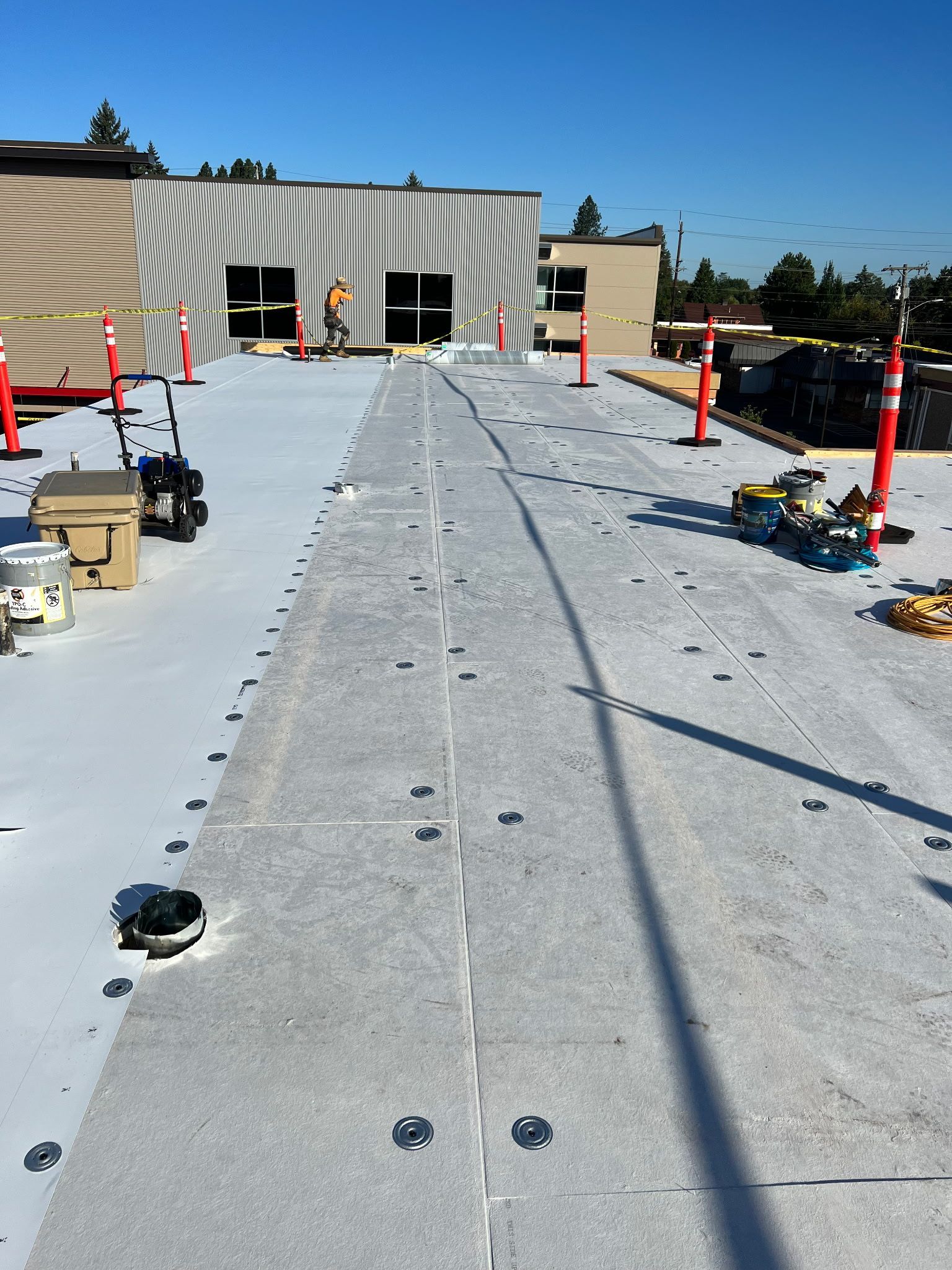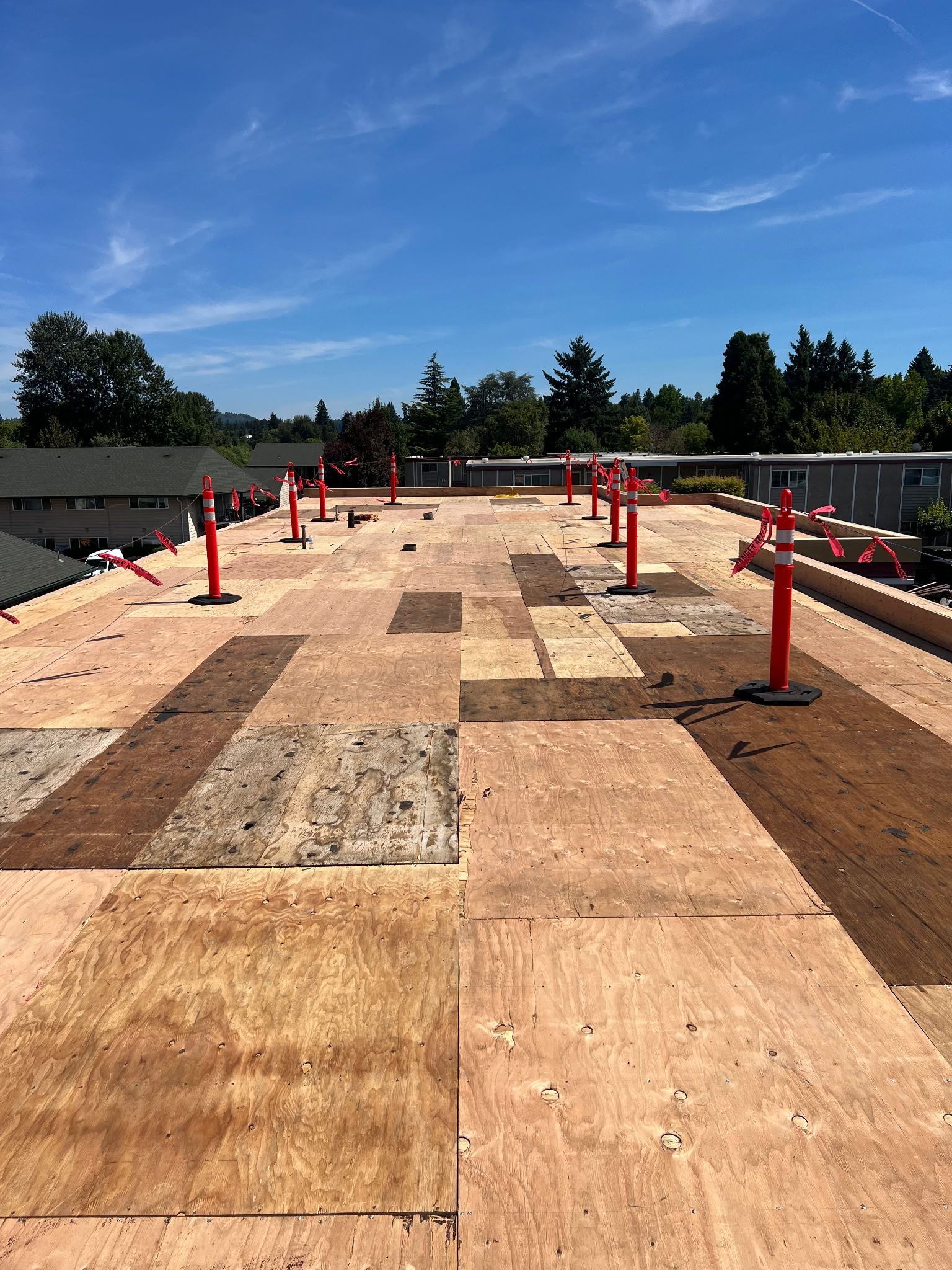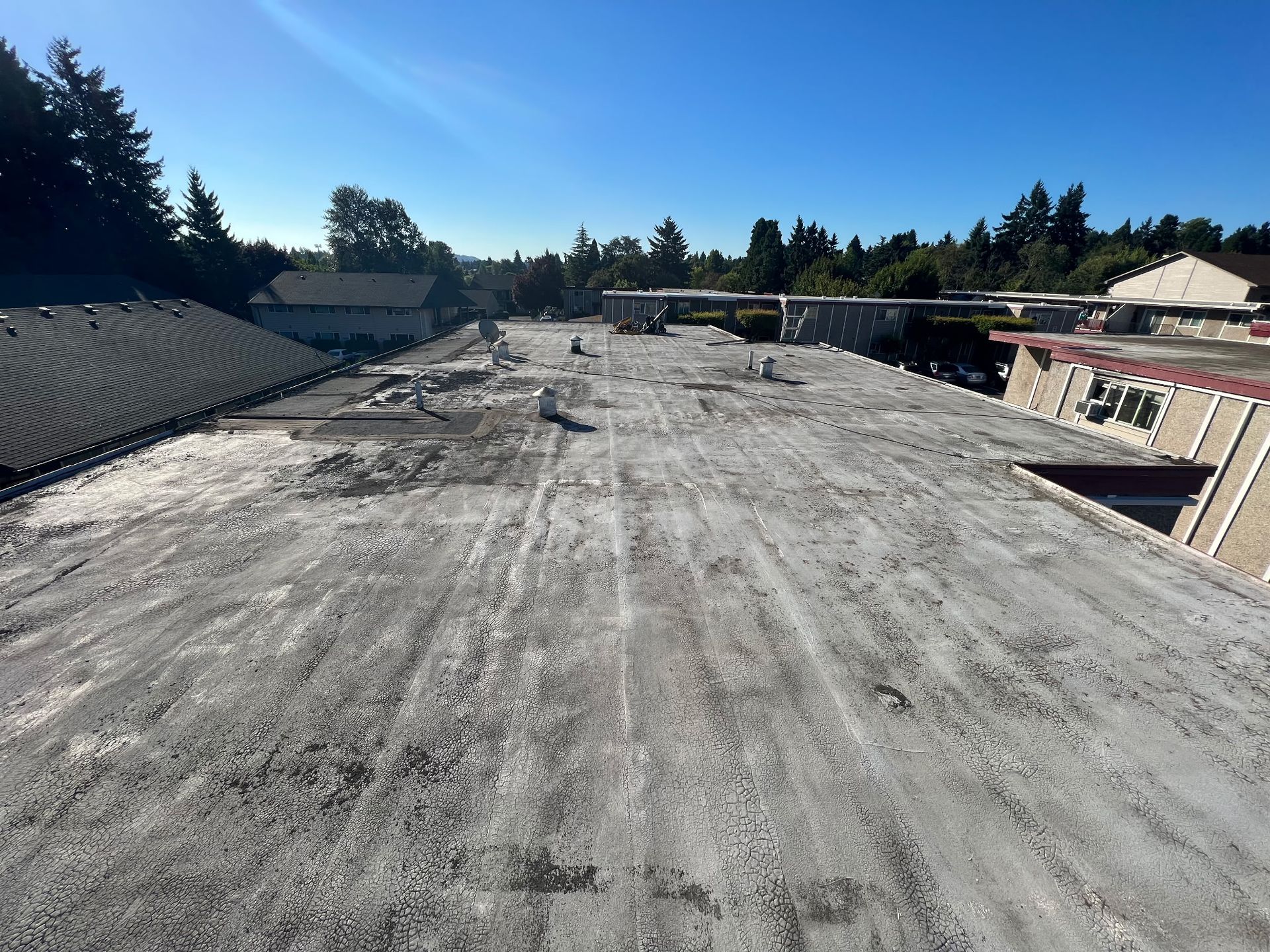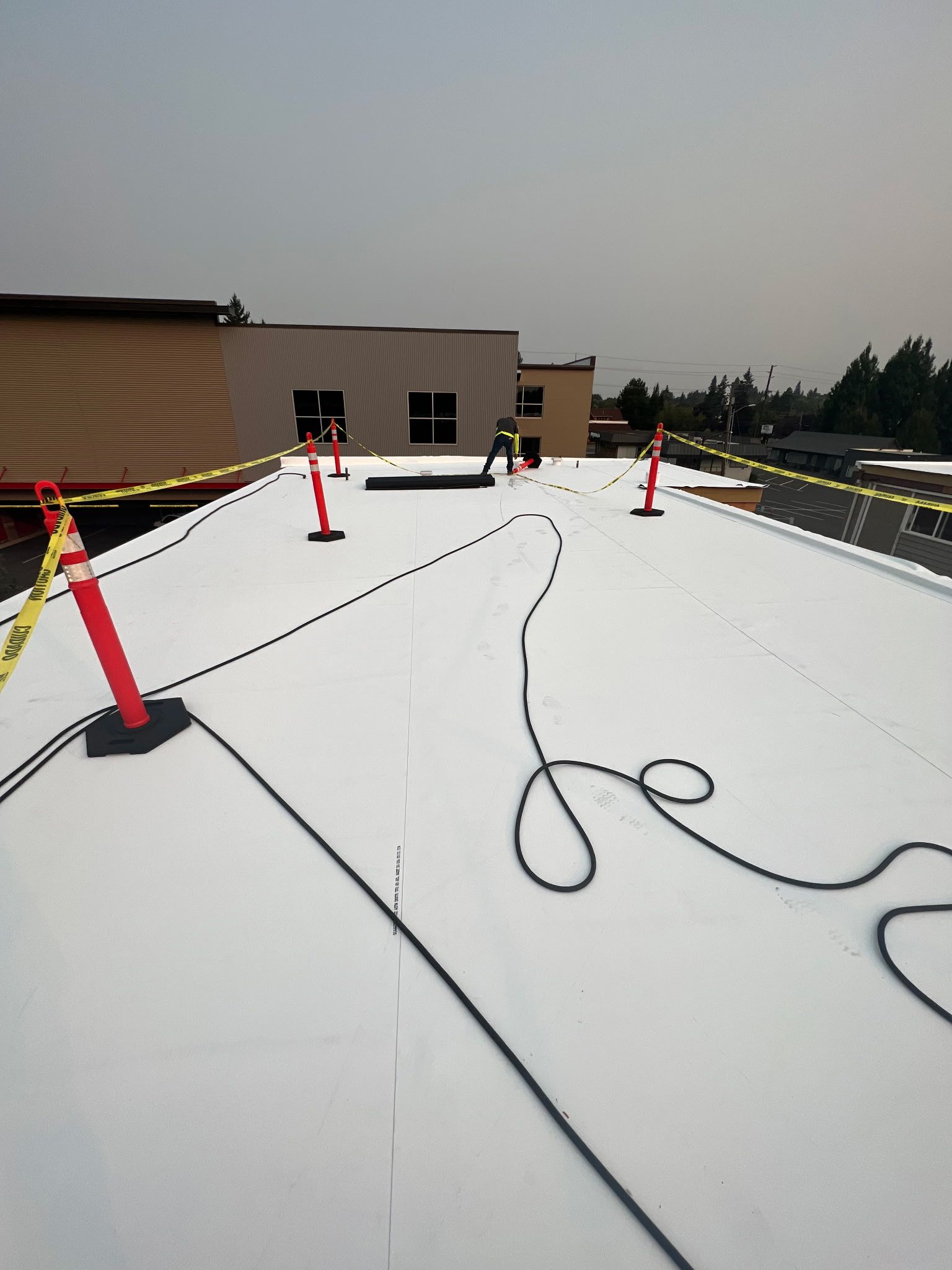
Full Replacements & New Roofs by Portland Commercial Roofing Pros
Get Your Free Estimate
Why Do Inspections and Preventative Maintenance on a Commercial Roof?
Why Do Inspections and Preventative Maintenance on a Commercial Roof?
As a commercial property owner or manager in Portland, your building’s roof is one of the most valuable—and vulnerable—investments you have. It shields your business from the elements, protects structural integrity, and ensures operations continue uninterrupted. But too often, commercial roofs are treated with a “set it and forget it” mentality until something goes wrong. That’s where inspections and preventative maintenance become mission-critical.
The True Cost of Neglect
A small leak doesn’t stay small. Without regular inspections, even minor damage can quickly lead to major problems like mold, interior water damage, insulation saturation, or even structural compromise. These issues don’t just cost money—they can shut down operations, damage inventory, and create legal liabilities if tenant spaces are affected. Preventative maintenance is the key to keeping your roof performing optimally and extending its life span. Compared to the cost of a full roof replacement—especially one that happens prematurely—routine upkeep is a fraction of the price.
What Is Preventative Maintenance?
Preventative maintenance is the only legitimate, proactive approach to roof care that you can possibly take. It involves regular inspections, minor repairs, debris removal, drainage clearing, and documentation of any potential problem areas. Think of it like regular oil changes and tune-ups for your car—you wouldn’t wait until the engine seizes to act.
For flat and low-slope roofs common in commercial buildings, this can mean:
- Sealing minor cracks in membranes
- Refastening loose flashing or coping
- Cleaning out roof drains and scuppers
- Recoating protective layers before UV or weather damage takes hold
- Checking for signs of ponding water or surface erosion
Why Regular Inspections Matter
Inspections—especially biannual ones (spring and fall)—provide a full diagnostic overview of your roof’s condition. Certified commercial roofing professionals are trained to spot vulnerabilities long before they become visible from inside the building. They also help document the condition of your roof, which is especially important for warranty claims and insurance coverage.
During an inspection, a contractor will assess:
- Roof membrane condition (TPO, PVC, EPDM, bitumen, etc.)
- Seams and fasteners
- Drainage systems
- Penetrations like HVAC units, vents, and skylights
- Flashing and edge details
Early identification of issues like bubbling, seam splits, or material shrinkage allows for small repairs instead of large-scale overhauls.
Key Benefits of a Roof Maintenance Plan
- Extended Roof Lifespan
A well-maintained roof can exceed its expected life cycle by 5–10 years. TPO and PVC membranes may last 20–30 years with proper care. Without it, their performance drops fast. - Lower Lifetime Costs
Preventative repairs cost significantly less than reactive ones. Fixing a failing seam now is cheaper than replacing soaked insulation or restoring an entire section of the roof later. - Improved Energy Efficiency
A roof in good shape helps maintain a tight building envelope, which supports your HVAC system and keeps utility costs down—especially important in Portland’s fluctuating climate. - Preserved Warranties
Most commercial roof warranties require regular maintenance, ours certainly do and it's likely that those from other companies do as well. Failing to document upkeep can void your warranty, leaving you exposed to full replacement costs. - Peace of Mind
Knowing your roof is being looked after lets you focus on your business—not on buckets catching leaks during a rainy Portland winter.
The Portland Climate Factor
Portland’s weather plays a major role in roof wear. Heavy rainfall, moss growth, freeze-thaw cycles, and UV exposure all take their toll on roofing systems. Preventative maintenance gives you an edge against these environmental factors. Regular cleaning and inspections can help clear moss and algae before they degrade roofing materials. Likewise, identifying clogged drains before a storm hits can prevent ponding water and load stress.
How to Get Started
The best way to begin is with a thorough inspection by a local commercial roofing expert familiar with the Portland area. From there, a customized maintenance plan can be developed to match your roof system and usage needs.
Most commercial property owners opt for a semi-annual maintenance plan with inspections in the spring (after winter weather) and fall (before the rains begin). Emergency visits for storm damage or leaks can also be built into your plan.
Conclusion
Investing in regular inspections and preventative maintenance is one of the smartest moves a commercial property owner can make. It saves money, extends roof life, and helps you sleep at night knowing your building is protected from the top down. If you’re unsure of your roof’s current condition—or haven’t had it checked in the last year—reach out to Portland Commercial Roofing Pros. We’ll help you put together a maintenance strategy that protects your business today and long into the future.
Roof Replacement Options
When your commercial roof starts to show signs of aging, persistent leaks, or structural wear, it may be time to consider replacement. But roof replacement isn’t a one-size-fits-all solution. The best approach depends on the existing system, the building’s use, climate considerations, and your long-term goals for the property. Whether you're managing a retail center, warehouse, office park, or industrial facility, understanding your roof replacement options can help you make the smartest, most cost-effective decision for your property and your business.
Full Tear-Off and Replacement
The most comprehensive option is a full tear-off. This involves removing the existing roof system down to the structural deck and installing a completely new membrane, insulation, and accessories. A full tear-off is ideal if the existing roof has extensive water damage, saturated insulation, or multiple failed layers. It also gives you the opportunity to upgrade insulation to meet modern energy codes, improve drainage, and select a long-lasting roofing material like TPO, PVC, or EPDM. While more expensive upfront, full replacement often provides the longest warranty options and allows you to fix underlying issues that patching would miss. For older roofs with poor documentation or multiple overlays, this is usually the safest long-term solution.
Roof Overlay (Re-Covering)
If the existing roof is still structurally sound and hasn’t exceeded the maximum number of layers (typically one, per most building codes), you might qualify for a roof overlay. This involves installing a new membrane over the old one, saving time and disposal costs. Overlays are most commonly used with flat or low-slope roofing systems like modified bitumen, TPO, or EPDM. Keep in mind, overlays don’t allow for inspection or replacement of underlying insulation or decking. If there’s hidden moisture trapped below, it could shorten the lifespan of the new roof. Still, this is a great option for budget-conscious building owners looking to extend roof life without the disruption of a full tear-off.
Roof Restoration with Coatings
For roofs that are aging but still performing reasonably well, roof coatings can be a smart third option. Silicone, acrylic, or elastomeric coatings can be applied over systems like metal, TPO, EPDM, or modified bitumen to add waterproofing, reflectivity, and weather resistance. Restoration is often significantly more affordable than replacement, and it’s less disruptive to building operations. Coatings can extend a roof’s life by 10–20 years and improve energy efficiency—especially useful for buildings with high cooling loads in summer. However, coatings are only viable if the existing membrane is dry and structurally intact.
Choosing What’s Best for Your Building
The right roof replacement approach depends on your current system, budget, and long-term property strategy. If you're unsure, a professional inspection and moisture scan will help determine whether a tear-off, overlay, or restoration is the right call. A qualified commercial roofing contractor can guide you through local building codes, warranty options, and material performance in Portland’s wet climate. Investing in the right replacement solution now means fewer headaches and lower costs down the road—and a roof that performs up to expectations at the time you need it to do so the most.



Planning a New Commercial Roofing Project

Planning a New Roof for Your Commercial Building: What to Know
Whether you're developing a new office complex, warehouse, retail center, or mixed-use property, one of the most critical components of your project is the roof. A well-designed and properly installed commercial roofing system protects your investment, supports energy efficiency, and contributes to the overall functionality and longevity of the building. Getting the roofing right from day one is essential—not just for compliance and durability, but for cost savings over time.
Choosing the Right Roofing System for Portland OR
The first major decision in a new commercial roof build is selecting the type of roofing system. The right choice depends on the building’s design, expected use, climate, and budget. Flat and low-slope roofs dominate in commercial construction due to their affordability and utility for HVAC systems and solar panels.
Here are a few common roofing systems for new commercial builds:
- TPO (Thermoplastic Polyolefin): Known for its durability, energy efficiency, and affordability, TPO is a white reflective membrane that performs well in sunny climates and can help reduce cooling costs.
- PVC (Polyvinyl Chloride): Similar to TPO, but with enhanced chemical resistance, PVC is ideal for buildings like restaurants or factories where grease or chemical exposure might be a factor.
- EPDM (Ethylene Propylene Diene Monomer): A black rubber roofing membrane that's highly flexible and weather-resistant. It's a long-lasting option, particularly in cooler climates.
- Metal Roofing: Standing seam or architectural metal panels offer excellent longevity and a modern aesthetic. Metal roofs also shed water easily, making them great for steep-slope designs or heavy rainfall areas.
Each system has its pros and cons, and the best fit will depend on your building’s specific needs and intended lifespan.
Key Considerations in a New Roof Build
A new roof isn’t just about the surface material. It’s a full system that includes insulation, drainage, flashing, and attachment methods. During planning, it’s vital to consider:
- R-Value & Insulation: Energy efficiency starts with proper insulation. Code requirements vary, but investing in a higher R-value can significantly lower long-term heating and cooling expenses.
- Drainage Design: Ponding water is a major threat to flat roofs. Ensure your plans include adequate slope and internal drains or scuppers to manage runoff.
- Code Compliance & Permits: Your roofing system must meet all local building codes and pass inspection. Working with an experienced commercial roofing contractor ensures everything is up to spec and avoids costly delays.
- Future-Proofing: Planning to install solar? Need rooftop HVAC? Consider how your roof can support future upgrades or mechanical systems.
Partnering with the Right Commercial Roofing Team
When it comes to new commercial construction, choosing the right commercial roofing experts can make or break your project. From design consultation and materials selection to final installation and inspection, an experienced team will keep the project on budget, on time and ensure that you have a roof that is built to last.